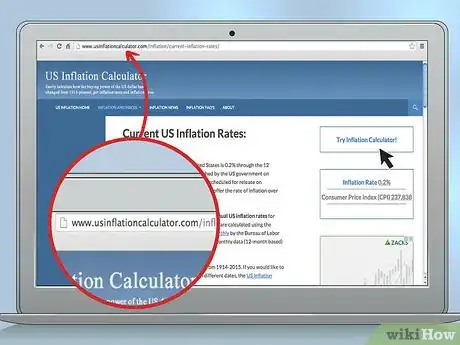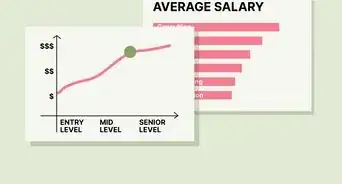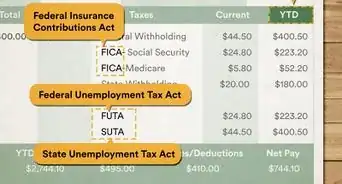This article was co-authored by Jill Newman, CPA. Jill Newman is a Certified Public Accountant (CPA) in Ohio with over 20 years of accounting experience. She has experience working as an accountant in public accounting firms, nonprofits, and educational institutions, and has also honed her communication skills via an MA in English, writing jobs, and as a teacher. She received her CPA from the Accountancy Board of Ohio in 1994 and has a BS in Business Administration/Accounting.
This article has been viewed 788,382 times.
Salary increases can take on many forms. You may have gotten a raise or a promotion, or you may have accepted a new, higher-paying job entirely. Regardless of circumstance, you probably want to know how to calculate your pay raise as a specific percentage of your old rate. Since inflation rates and cost of living statistics are often expressed as percentages as well, calculating an increase as a percentage can help you compare the increase to other forces like inflation. Learning how to work out a salary increase percentage will also help you to compare your compensation against others in your field.
Steps
Calculating Your Salary Increase Percentage
-
1Subtract your old salary from your new salary. Say you made $45,000 per year at your old job and that you accepted a new position making $50,000 per year. This means you would take $50,000 and subtract $45,000. $50,000 - $45,000 = $5,000.
- If you receive hourly pay and don’t know your total yearly earnings, you can simply use the old and new hourly rate in place of the salary. For instance, if the raise was from $14/hour to $16/hour, then you would use $16 - $14 = $2.
-
2Divide the salary difference by your old salary. In order to turn the increase amount into a percentage, you must first calculate it as a decimal. To get the decimal you want, take the difference calculated in Step 1, and divide it by the amount of your old salary.
- Based on the example from Step 1, this would mean taking $5,000 and dividing it by $45,000. $5,000 / $45,000 = 0.111.
- If you’re calculating the hourly percentage increase, this would still work the same way. From the previous hourly example, take $2 / $14 = 0.143
Advertisement -
3Multiply the decimal figure by 100. To turn a number expressed in a decimal format into a percentage, simply multiple it by 100. Using the previous example, you would multiply 0.111 by 100. 0.111 x 100 = 11.1% This means that the new salary of $50,000 is roughly 111.1% of the previous $45,000 salary or that you received an 11.1% increase.
- For the hourly rate example, you would still multiply the decimal number by 100. This would make the previous hourly example 0.143 x 100 = 14.3%.
- To check your work, multiply your original salary or hourly rate by the increase percentage. For example, if you multiply $45,000 x 1.111, the answer is is $49,995, which rounds up to $50,000. Likewise, $14 x 1.143 = $16.002.
-
4Factor in additional benefits if applicable. If you’re comparing a new job at a new company rather than just a salary increase or promotion at your current company, then the salary might be just one part of the overall benefits package to consider. You’ll have a wide range of other items to factor into your increased bottom line. Some of these items include:
- Insurance benefits/premiums - If both jobs offer employer-based insurance coverage, then you’ll have to compare the coverage of the insurance plans. You’ll also need to factor the premium (if applicable) taken out of your paycheck into your decision. Going from paying $100/month to $200/month in insurance premiums for the same coverage would negate some of your salary increase, for instance. Also consider the depth of the coverage (do they include dental or vision?), the overall yearly deductibles you may have to pay, etc.
- Bonuses or commissions - Though not part of your standard salary, don’t forget to include bonuses and/or commissions in each calculation. The new salary might offer more each paycheck, but if your current job has the potential for quarterly bonuses, for instance, does the increase still pan out? Keep in mind that this amount may not be consistent because it will probably depend on your performance and/or the company’s performance.
- Retirement plans - Most companies offer a 401k retirement plan that allows you to take pre-taxed wages and put them aside for your retirement. Many companies match up to a certain percentage of an employee’s contribution to his or her personal 401k. If your current company does not match and your new company matches up to 6%, then that’s essentially free additional money toward your retirement to consider.
- Pensions - Jobs that offer pensions for certain numbers of years of continuous service also require consideration. If your current position offers a great pension after twenty-five years, but the new position doesn’t offer any type of pension, then you should consider that as well. A higher yearly salary might be more money immediately, but it’s also worth considering the lifetime earning potential of each. However, keep in mind that pensions are not the norm today. They still exist, but they do not always pay out as expected. In some cases, the funds have been mismanaged and there is little or nothing left for people to retire on.
Determining How Your Increase Relates to Inflation
-
1Understand inflation. Inflation is an increase in the prices of goods and services, so it has an effect on your cost of living. High inflation, for instance, often means an increase in food, utility, and gas prices. People tend to buy less during periods of high inflation because these periods mean higher prices.
-
2Look up inflation. A wide range of factors determine the inflation of currency. In the U.S., the Department of Labor’s Bureau of Labor Statistics releases a monthly report following and calculating inflation.[1] You can find a month-by-month breakdown of U.S. inflation rates for the past fifteen years here.
-
3Subtract the inflation rate from your increase percentage. To determine the effect inflation has on your increased salary, simply subtract the rate of inflation from the increase percentage you calculated in Part 1. For example, the average inflation rate in 2014 was 1.6%.[2] Using the 11.1% increase rate calculated in Part 1, you would determine the effect of inflation on the raise like so: 11.1% - 1.6% = 9.5%. This means that once you take into account the inflated prices of standard goods and services, the increase is only worth an extra 9.5% because the money is worth 1.6% less than the previous year.
- In other words, it took on average 1.6% more money in 2014 to buy the same items as in 2013.
-
4Relate the effect of inflation to purchasing power. Purchasing power refers to the comparative costs of goods and services over time. For instance, say you have the salary of $50,000 per year from Part 1. Now say that inflation stays at a flat 0% the year you get the raise, but rises 1.6% the following year without you receiving another raise. This means it will take you an additional 1.6% to purchase the same basic goods and services. 1.6% of $50,000 is equal to 0.016 x 50,000 = $800. Your overall purchasing power based on inflation actually decreased by $800 over the previous year.
- The Bureau of Labor Statistics has an easy-to-use calculator for comparing purchasing power between years.[3] You can find it at: http://www.bls.gov/data/inflation_calculator.htm
Expert Q&A
Did you know you can get expert answers for this article?
Unlock expert answers by supporting wikiHow
-
QuestionA new employee is requesting a starting salary of $40,000 per year. The base salary is $38,696.82. How do you figure the percentage over base salary?
 Michael R. LewisMichael R. Lewis is a retired corporate executive, entrepreneur, and investment advisor in Texas. He has over 40 years of experience in business and finance, including as a Vice President for Blue Cross Blue Shield of Texas. He has a BBA in Industrial Management from the University of Texas at Austin.
Michael R. LewisMichael R. Lewis is a retired corporate executive, entrepreneur, and investment advisor in Texas. He has over 40 years of experience in business and finance, including as a Vice President for Blue Cross Blue Shield of Texas. He has a BBA in Industrial Management from the University of Texas at Austin.
Business Advisor
-
QuestionA 5% monthly salary increase resulted in a salary increase of tk6000 per year for an employee. What was his monthly salary before the increase?
 Jill Newman, CPAJill Newman is a Certified Public Accountant (CPA) in Ohio with over 20 years of accounting experience. She has experience working as an accountant in public accounting firms, nonprofits, and educational institutions, and has also honed her communication skills via an MA in English, writing jobs, and as a teacher. She received her CPA from the Accountancy Board of Ohio in 1994 and has a BS in Business Administration/Accounting.
Jill Newman, CPAJill Newman is a Certified Public Accountant (CPA) in Ohio with over 20 years of accounting experience. She has experience working as an accountant in public accounting firms, nonprofits, and educational institutions, and has also honed her communication skills via an MA in English, writing jobs, and as a teacher. She received her CPA from the Accountancy Board of Ohio in 1994 and has a BS in Business Administration/Accounting.
Financial Advisor
Things You'll Need
- Calculator
References
About This Article
To work out salary increase percentage, start by subtracting your old salary from your new salary. Next, divide the salary difference by your old salary in order to turn the increase amount into a decimal. Then, multiply the decimal figure by 100 to turn the number expressed in decimal format into your salary increase percentage. If you're comparing two jobs, you may also want to consider comparing factors like insurance benefits and premiums, bonuses, commissions, retirement plans, and pensions. To learn more from our Accountant co-author, like how to calculate with inflation, keep reading the article!




































































